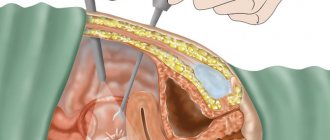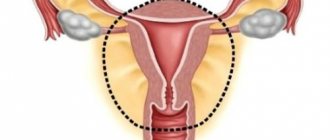Processes in the cervix
The second reason for a woman’s cycle to fail is the proliferation of abnormal cells in the cervix.
Due to this proliferation, menstrual blood cannot leave the vagina. When menstruation arrives, it is heavier than usual and accompanied by pain. This type of pathology occurs less frequently, but it is much more dangerous due to the high risk of developing into cervical cancer. Even if the process has not become malignant, it is still undesirable due to the formation of adhesions in the cervical canal. Adhesions prevent a woman from getting pregnant. Sperm entering the vagina are unable to reach the egg to fertilize it.
Hormonal imbalance in the body slows down the development of eggs in the ovaries, so menstruation occurs later than usual. Due to hormonal disorders, the endometrium cannot mature by a certain time, so there is no uterine bleeding. The female body is designed in such a way that the uterus is prepared during the cycle to receive a fertilized egg. If a girl has endometriosis, the natural process is disrupted, which affects the entire body.
Delay
Endometriosis most often affects young girls and women before menopause. The symptoms of this disease and its effect on the menstrual cycle largely depend on the age of the patient and the characteristics of the pathology. Endometriosis can be genital and extragenital. In the first case, only the genital organs are affected, and in the second, adjacent ones as well.
Delayed menstruation with endometriosis can have several main reasons, namely:
- Pregnancy. Patients with endometriosis are often diagnosed with infertility. However, in rare cases, the disease can occur during pregnancy. This pathology is especially dangerous, as it can lead to miscarriage. If you are planning to conceive a child, be sure to undergo a full examination first and make sure that you do not have endometriosis.
- Damage to the inner layers of the uterine walls. With abnormal growth of endometrial cells, the functioning of the ovaries is disrupted. Because of this, menstruation is delayed. If the duration of the cycle constantly increases, you should immediately contact a gynecologist. If there is a lack of female hormones, menstruation may stop altogether.
- Damage to endometriosis of the cervix. Growths of endometrial tissue prevent the passage of menstrual flow. The patient may experience a prolonged delay in menstruation, and then begin to bleed heavily and painfully. This form of endometriosis is very dangerous, as it can become malignant. As the pathology progresses, adhesions form in the cervical canal, which limits the movement of sperm and leads to infertility.
- Hormone imbalances. Due to excessive production of the hormone estrogen and insufficient production of progesterone, the egg develops more slowly. In this case, the endometrium matures on time, but bleeding does not begin. This disruption of the natural process is accompanied by pain and discomfort.
Causes of endometriosis
Endometriosis ranks third among the most common gynecological diseases after various inflammations and uterine fibroids. Today, all the causes of this disease are still not clear. Some scientists claim that hereditary factors and poor ecology are to blame, while others suspect a violation of the hormonal balance and the woman’s immune system.
In some patients, endometrial particles enter other organs and directly into the blood during menstrual flow, and then they attach to the tissues and continue to function unhindered. If fertilization does not occur, the endometrium is rejected, as in the uterine cavity, while creating pressure in the place where it is attached, causing pain and discomfort.
There is a group of factors that increase the risk of developing a pathological process:
- heredity;
- decrease in the hormone progesterone and increase in the amount of estrogen;
- first pregnancy after 30 years;
- difficult birth with various complications;
- artificial termination of pregnancy;
- C-section;
- cervical biopsy, cauterization of erosion and other methods.
During treatment of the cervix immediately before the onset of menstruation, cells sometimes enter the fresh wound and subsequently grow. Bad habits and poor nutrition also affect your overall health and increase the risk of developing a pathological process.
Menstrual pain with endometriosis
A characteristic symptom is pain during menstruation with endometriosis. Critical days, even in full health, rarely go without these sensations. But the disease sometimes makes them intolerable. Nagging pain occurs even before the critical days. It starts in the lower abdomen, extends to the lower back, and can be accompanied by brown smear. Sensations take over the pelvic area, subside and increase.
Endometriosis complements painful periods with other unpleasant symptoms:
- Nausea, possibly vomiting;
- Severe weakness;
- Difficulty urinating if the cells of the inner lining of the uterus have grown into these organs;
- Problems with stool.
The sensations can be constant, shooting, aching, gripping, but always very pronounced. What makes them so is the abnormal location and rejection of endometrial tissue with damage to blood vessels.
A woman needs to be especially attentive after a long delay. The consequence of the disease can be an ectopic pregnancy, the likelihood of which increases in connection with it, especially when endometrial cells have penetrated the fallopian tubes. It is easier for the sperm to reach the female reproductive cell, but after their union, the growing fertilized egg does not have the opportunity to descend into the organ cavity. It remains in the fallopian tube and, as it develops, ruptures it, causing bleeding and severe pain.
Endometriosis also provokes pain after menstruation due to the fact that due to an increase in the amount of tissue in the inner lining, the blood supply to the uterus increases. And its germination into the ovaries and fallopian tubes irritates the nerve receptors of the abdominal cavity.
Endometriosis and menopause
Pain in the lower abdomen during menopause indicates this illness. It develops against the background of a restructuring of a woman’s hormonal system and a decrease in immune defense.
Endometritis and endometriosis in the climatic period occur against the background of:
- obesity, which leads to metabolic disorders;
- diabetes mellitus, which stimulates the production of estrogen; this hormone is no longer produced at the age of 50+, and it, in turn, provokes the growth of the endometrium;
- scars after surgical operations (removal of fibroids), laparoscopy.
At the age of menopause, and even more so during the postmenopausal period, a number of complications develop against the background of endometriosis, among which posthemorrhagic anemia is dangerous. It is characterized by significant blood loss due to endometrial detachment in this disease. Intra-abdominal bleeding is especially difficult at this age, causing death.
Therefore, obstetricians recommend that women in menopause visit their gynecologist as often as possible (once every 6-12 months) to avoid the development of such a disease and its complications.
Methods to combat pathology and consequences
They fight endometriosis in three ways.
- Eliminating or dulling pain.
- Regulation of the volume of secretions.
- Getting rid of foci of the disease and completely eliminating the pathology.
Usually, drugs such as No-Shpa, Spasmalgon, Combispasm, Solpadeine and others are used to relieve pain. There are more potent drugs, but they should only be prescribed by a doctor. By and large, regular paracetamol is enough, and if it does not relieve pain, then further symptomatic treatment should be carried out only with a doctor.
By eliminating pain, you only remove one of the symptoms, but the disease does not go away. A gynecologist is needed to treat it. Therefore, it is better to go to the doctor, and therefore take painkillers.
There are many medications that can be used to reduce bleeding during menstruation. These include Ascorutin, Diferelin, Tranexam, Vikasol, Dicynon, Oxytocin, Ergometrine and others. Some drugs are used directly to treat endometriosis, others are needed to contract the uterus, and others are hemostatic agents. Therefore, consulting a doctor is mandatory, because you won’t be able to choose the treatment yourself.
If necessary, the gynecologist can prescribe hormonal therapy (usually this happens) using the following drugs:
- dinazole;
- monophasic oral contraceptives of the combined type;
- Nemestran (Gestrinone);
- Dienogest and other progestin preparations;
- Decaleptil.
It is better not to use tampons for endometriosis, as in other situations with heavy periods. It is necessary to see the volume of secretions, and also not to let them stagnate. Gaskets are the best choice in this situation.
Fans of traditional medicine use decoctions of nettle, yarrow, horsetail, pepper, viburnum bark and other plants. These decoctions should help stop the bleeding. However, we are talking about unproven medicine, so you can simply waste precious time on ineffective treatment methods.
Diagnosis and treatment
Endometriosis is more common in patients before menopause; it also occurs in adolescents. The delay occurs as a result of the development of the disease. Gynecologists distinguish endometriosis of genital and extragenital forms. The genital form is diagnosed when the uterus, tubes, ovaries or vagina are affected. The extragenital form is determined when endometrial cells are found in neighboring organs that do not belong to the reproductive system.
Diagnosis of endometriosis is difficult because in the initial stages there are often no symptoms. If symptoms are present, they are similar to signs of other gynecological pathologies. What to do to make an accurate diagnosis?
Preventative examinations with a gynecologist will help to detect the disease in a timely manner and avoid serious complications. With endometriosis, secondary infertility occurs in a quarter of patients.
The diagnosis is confirmed after a number of examinations, including examination, ultrasound, culture and biopsy. The main goals of modern treatment of this pathology are to reduce pain, relieve inflammation, and preserve the patient’s fertility. The course of treatment greatly depends on the age of the patient, as evidenced by reviews on the Internet. Two treatment tactics are used - medication or complex with surgical intervention.
Delayed periods with endometriosis are common, as is unexpected uterine bleeding. Among the drugs for endometriosis, hormonal drugs are used that stop menstruation for the period of treatment. Usually these are gestagens that reduce the synthesis of estrogen and stop ovulation. They are used in the early stages of the disease.
In addition to hormones, analgesics, anti-inflammatory drugs and immunostimulants are used. Surgery is prescribed only for severe forms of the disease to remove foci of inflammation. With proper treatment, in most cases it is possible to completely restore the patient’s health.
Higher medical education, specialty obstetrics and gynecology, studied at Kazan State Medical University. Co-author of scientific publications.
How and when to operate for endometriosis
The disease at the initial stage with small foci of cell proliferation is treated conservatively using hormonal drugs. But in most cases, surgical methods followed by the use of the same medications are necessary to preserve reproductive capabilities. When the cells of the uterine mucosa are localized in its cervix and cavity, scraping or cleaning is used. The functional layer is removed with instruments and sent for examination. What remains is the sprout, which retains the ability to form external cells, that is, all functions of the organ are preserved.
Endometriosis must be cleaned during menstruation if it is an emergency operation due to heavy bleeding. It can also be done routinely on critical days, if a diagnosis was previously carried out, and the material has already been examined, and the diagnosis has been confirmed. This is a more physiological and gentle method, since the endometrium is already rejected. Curettage during menstruation minimally injures the organ and allows you to restore its functions in a short time. A planned operation can be carried out several days before, then the resulting material is sent for research. In addition, endometriosis before menstruation is especially clearly visible due to the cyclical nature of its development. This is important, because accidentally leaving minimal lesions will inevitably cause a relapse.
The spread of the disease to the ovaries, appendages, and other organs will require laparoscopic surgery and also removal or cauterization of tissue, followed by hormonal therapy.
What is the reason for delayed periods due to endometriosis?
The development of endometriosis is influenced by the lifestyle of modern women. The immune system reacts inadequately to the changes occurring, and “wandering” endometrial cells are implanted in unusual places.
Typical symptoms of the disease:
- Pain anytime and anywhere: in the lower abdomen, in the rectum, during sexual intercourse, during menstruation, etc.
- Spotting before and after menstruation as a sign of delayed endometrial rejection.
Delayed menstruation is an atypical condition for endometriosis. But the paradox is that the pathology is very often associated with other diseases of the reproductive systems, which may be the cause of the delay. Most likely, the connection here lies in the common beginning of their development.
Endometriosis is a “travelling” disease. Lesions can be found theoretically in any place and organ. Cases of endometriosis of the eye, brain, and liver have been described; lesions are often found on the intestines, bladder, and abdominal covering of internal organs.
Classification of endometriosis
Endometriotic damage to the structures of the uterine body is called adenomyosis. In this case, lesions are found in the endometrium, muscle layer and can “drill” through the uterus. For a number of reasons, adenomyosis is often associated with endometrial polyps of various natures and glandular hyperplasia. All of these conditions are associated with delayed periods. Treatment is similar: mainly hormonal drugs and surgical removal of lesions are used.
In half the cases, endometriosis is combined with myomatosis, for which hormonal disorders and cycle disruptions (delays, bleeding) are common.
The emerging endometrioid lesions on the ovaries transform into cysts over time. They grow due to the constant secretion of fluid inside, like menstrual fluid, so their contents are always dark in color. Endometrioid cysts literally “eat” the ovaries.
This is due to the following:
- The lesions grow, new ones appear, this leads to the death of nearby tissue.
- It is recommended to remove endometrioid cysts, as they are still prone to malignancy. The ideal method is laparoscopic surgery. Cauterization leads to additional damage to ovarian tissue. The function of the ovaries is disrupted and malfunctions occur. A shortening of the cycle, a decrease in the volume of discharge and the number of critical days after surgery is the first signal of ovarian depletion and imminent (in the next 5-10 years) menopause.
Endometriosis often accompanies polycystic disease, where retention is a typical symptom.
Cervical endometriosis in general is not characterized by delays. This is only possible in the case of a large lesion or complete tissue damage, which can result in the formation of a mechanical obstacle to the outflow of blood. The clinical picture is clear: the woman complains of pain in the lower abdomen, which is increasing.
An ultrasound reveals a secretion in the uterine cavity that creates pressure on the walls and initiates pain. Restoring the flow of menstrual flow immediately leads to relief and disappearance of symptoms.
A delay in endometriosis, especially during treatment with hormonal drugs, should always alert a woman. First of all, you need to do a urine test or take a blood test for hCG to exclude pregnancy, and then look for another cause of failure.
You should immediately see a doctor if you are concerned about the following:
- intense pain in the lower abdomen due to delay;
- deterioration in general health: weakness, lethargy, dizziness, drop in blood pressure;
- there are signs of pregnancy;
- body temperature has increased, strange discharge from the genital tract is bothering me.
Read more in our article about late periods due to endometriosis.
Read in this article
Briefly about the disease
The endometrium is the upper layer of the inner cavity of the uterus, part of which is regularly separated and excreted, replaced by a new one. Under the influence of various factors, whose nature is not fully understood, this tissue begins to grow outside the organ. During examination, it is seen mainly within the genitourinary system, and sometimes in different parts of the intestine. Naturally, menstruation with endometriosis of the uterus contains not only the cells of its inner lining, but also those neoplasms that are localized in other organs.
Hormonal disorders are both one of the causes and a consequence of the disease. Therefore, menstruation with such a diagnosis is also characterized by irregularity. Sometimes this makes you wonder whether there are periods with endometriosis in principle, since the disease affects the main organ involved in the process. Menstruation not only comes, but it is easy to confuse it with uterine bleeding. However, cycle failure and long delays with endometriosis are also not excluded.
Therapy methods
Treatment of the pathology depends on age characteristics, the number of births and pregnancies, the prevalence and location of lesions, and the severity of symptoms. The desire to realize reproductive function is essential.
Treatment includes surgical and therapeutic methods. Surgical techniques can be organ-preserving and radical. Therapy is carried out not only to eliminate symptoms, but also to prevent consequences, for example, infertility.
Conservative treatment is recommended mainly for young patients with asymptomatic disease, as well as premenopausal women. The drugs used make it possible to preserve and restore reproductive function.
Conservative therapy involves the use of hormonal medications:
- combined estrogen-progestin agents;
- gestagens;
- antigonadotropic drugs;
- gonadotropin releasing hormone agonists.
Complementing drug treatment:
- analgesics;
- antispasmodics;
- NSAIDs;
- immunostimulants.
Organ-preserving laparoscopic and laparotomic interventions with removal of endometriotic lesions are carried out in the presence of a moderate or severe stage of the disease. During the operation, heterotopias are cauterized and adhesions are dissected. Surgery can be supplemented with drug therapy.
Important! Radical surgery is recommended for premenopausal women with severe signs of endometriosis and ineffectiveness of other treatment methods.
Symptoms of endometriosis
Endometriosis is a pathology in which the endometrial tissue, which normally covers the uterine cavity from the inside, begins to grow and affect other organs.
The main signs that allow one to suspect the presence of this pathology are the following:
- the occurrence of pain during menstruation and before its arrival;
- changes in the menstrual cycle and the nature of discharge (amenorrhea, dysmenorrhea and hypominorrhea);
- delay of menstruation;
- sometimes spotting appears at a time that is not consistent with the monthly cycle;
- infertility.
Sometimes in the initial stages the signs of this disease are not particularly noticeable, but changes in the nature of menstruation with endometriosis are always observed , and as the pathology progresses, the symptoms become more pronounced.
The nature of menstruation after treatment of endometriosis
Menstruation after endometriosis with curettage should come in accordance with the calendar. The delay may be minimal and is associated with stress. Usually they are much less painful and abundant than they were before the intervention.
If menstruation after treatment for endometriosis still causes suffering, is intense, with clots, the woman should be examined again. It is likely that an infection was introduced during the operation or that not all foci of the disease were eliminated.
Laparoscopy for endometriosis and menstruation
It is worth paying close attention to what happens immediately after laparoscopy. A foul odor and brown discharge indicate an inflammatory process that requires immediate intervention and elimination.
In comparison with the consequences of curettage, menstruation after laparoscopy manifests itself a little differently; endometriosis in these cases affects a significant part of the reproductive system. This means that surgical intervention is more extensive and traumatic. Therefore, the stress associated with it can delay menstruation by 2-3 months. Immediately after the operation, bleeding may occur, but this is not menstruation, but a negative consequence that needs to be eliminated. Delayed menstruation after laparoscopy for endometriosis may be due to
- The age of the patient;
- General health;
- Psychological mood.
In most cases, after surgery, a course of hormones is prescribed, which postpones it for the entire duration of treatment. After it, menstruation is usually quite heavy, which indicates restoration of the ovaries. But the intensity of the discharge is incomparable to what it was during the disease. There shouldn’t be any clots in them either; with this symptom you need to see a doctor immediately. Normally, the consistency of the discharge is uniform.
At any level of intervention, the woman should avoid sexual intercourse, significant physical exertion, hot baths, and douching for at least a month.
The nature of menstruation with endometriosis can make these days difficult and dangerous. You should not suppress the pain with pills and use only hemostatic drugs. All these are half measures that will not relieve suffering for long, but will give time for the disease to develop and take over large areas of the reproductive system, lead to infertility, and increase the likelihood of cells degenerating into cancerous ones. It is more reliable to treat endometriosis at an early stage, and in order to “catch” the disease in time, it is necessary to be thoroughly examined for the slightest changes in menstruation and the cycle in general.
Before using any medications, you should consult a specialist doctor. There are contraindications!
Bloody discharge during menopause: normal or pathological?
Menopause is the last menstruation in a woman's life. It is detected after the fact: after these periods there should be no discharge for a year. If menstruation returns within 12 months, it is referred to as perimenopause. The woman has already entered menopause, but the last menstruation has not yet been recorded, and the ovaries continue to function.
If a year or more has passed since the last menstruation, they speak of postmenopause. During this period there should be no bleeding from the vagina. The appearance of even minor discharge is a reason for examination by a gynecologist. This symptom occurs with endometriosis and some other conditions: uterine fibroids, endometrial hyperplasia, polyps.
It is important to know
Bloody discharge is one of the symptoms of uterine cancer. The risk of developing a malignant tumor increases sharply during postmenopause.
Bloody discharge during menopause is one of the signs of cancerous tissue changes.
Endometriosis therapy
There are 2 treatment options: medication and folk remedies. In any case, only a doctor can prescribe a treatment regimen.
Drug treatment
Since the disease is subject to the female endocrine system, its course can be influenced by regulating hormonal processes. One of these medications is Visanne. In case of uterine endometriosis, it normalizes the production of estrogen, inhibiting the process of proliferation of the epithelium, as well as the vascular network that nourishes it and destroys endometrial foci outside the body of the uterus.
Another equally effective hormonal drug containing gestagens is Duphaston. It also has an inhibitory effect on estrogens, which become the culprits of this pathological condition. The drug anesthetizes the area of tissue affected by endometriosis and normalizes the menstrual cycle.
Doctors resort to the use of Oxytocin in cases where an urgent stop of bleeding is required. It has a stimulating effect on the muscles of the uterus, due to which the epithelium comes out faster and with less blood loss. The dosage of this drug at home should not be calculated, as this may further aggravate the symptoms.
Folk remedies
Chinese tampons, which have recently gained popularity among women, have minimal side effects. According to the manufacturer, they contain only natural ingredients that help normalize the cycle and discharge during endometriosis, and also improve blood circulation in the genitals and relieve pain. But they are effective only in the initial stages of the disease, which do not threaten health or life. If there is heavy bleeding due to endometriosis, you should immediately seek medical help.
Many women resort to local hormonal contraceptives, which have long proven themselves not only as a preventive measure, but also as a method of treating such a disease. These include intrauterine devices, such as Mirena.
The following hemostatic and anti-inflammatory drugs (herbs) of traditional medicine are distinguished:
- Gauze swabs:
- honey-propolis;
- from honey and aloe;
- with sea buckthorn oil;
- with mumiyo.
- Borovaya uterus is used to reduce foci of disease, stimulate local immunity and have a gentle effect on disrupted hormonal levels.
In general, the prognosis for this pathology is positive, since any woman, having undergone competent treatment, will be able to become pregnant in the future and lead a full life.
Uterine bleeding is a dangerous complication of endometriosis
One of the common complications of endometriosis is uterine bleeding. It comes in two forms:
- Menorrhagia. Heavy menstruation lasts more than 7 days and turns into uterine bleeding;
- Acyclic bleeding. Occurs on any day of the cycle and is accompanied by copious bleeding.
It is also useful to read: Indinol and Epigallate in the treatment of endometriosis
Causes of uterine bleeding:
- Distribution of heterotopias and damage to the deep layers of the myometrium. The structure of the organ is disrupted, and endometrial rejection occurs. Heavy bleeding is characteristic of adenomyosis;
- Ovarian cyst. Education prevents ovulation and leads to prolongation of the menstrual cycle. The endometrium grows and is rejected with the development of heavy bleeding.
Signs of dangerous bleeding:
- Menstruation is profuse, clots persist for more than 3 days;
- The volume of menstruation does not decrease after 3-4 days from the start of the discharge;
- The total duration of menstruation is 8 days or more;
- Menstruation is accompanied by severe pain in the lower abdomen;
- Blood loss during the day - more than 80 ml (absorbent pads need to be replaced every hour);
- Acyclic discharge between periods does not stop for 1-2 days or intensifies.
Frequent bleeding leads to the development of anemia, severe bleeding threatens a woman’s life. In case of heavy blood loss, urgent hospitalization in a gynecological hospital is necessary.
Heavy, continuous bleeding requires urgent hospital treatment.
Protocol for assistance with uterine bleeding due to endometriosis:
- Hormonal hemostasis is possible in girls under 18 years of age with moderate bleeding. Combined oral contraceptives are prescribed in high doses. The dosage of the drug is gradually reduced. After bleeding has stopped, it is recommended to drink COCs for 21 days;
- Surgical hemostasis is indicated in reproductive age (18-45 years), premenopause and postmenopause. A diagnostic and therapeutic curettage of the uterine cavity is performed under hysteroscopy control. The resulting material is sent for histological examination;
- Hysterectomy (removal of the uterus) is performed for bleeding that threatens a woman’s life if other methods cannot stop the blood loss.
During the recovery period, taking vitamins is recommended. Iron supplements are prescribed to correct anemia.
It is important to know
It is impossible to stop severe uterine bleeding at home. This is a life-threatening condition. Emergency assistance from a gynecologist is required. Without treatment, blood loss will worsen and death may occur.
Nature of the discharge
The cyclicity and nature of menstruation with endometriosis may differ from patient to patient. Here everything depends on various factors - the characteristics of the body, the degree of development of the pathology, as well as the localization of the pathological endometrium.
Let's look at several abnormalities of the menstrual cycle that most often occur in patients with endometriosis.
Menstruation with endometriosis is heavy, often with blood clots. Such discharge may be accompanied by additional unpleasant symptoms - pain in the lower abdomen, radiating to the lower back. The increase in the volume of menstrual blood is explained by the fact that endometrial tissue grows and there are more of them, especially on the fallopian tubes. When the time comes for menstruation, such tissues are rejected on their own and leave the body naturally. Spotting may persist even after the end of menstruation.
Menstruation with endometriosis is scanty. This symptom indicates that endometriosis is affecting the vagina and the outer layer of the uterus. With this pathology, menstruation is spotty, but lasts quite a long time. The progression of the pathology can lead to damage to the rectum and urinary system.
In this case, the patient may discharge blood from the anus during menstruation, and stool disturbances are observed. Scanty menstrual flow is almost painless for the patient. If any discomfort does occur, you can get rid of it with simple painkillers.
Delayed menstruation with endometriosis is the most common phenomenon. Due to an imbalance of hormones in the female body, the process of full development of endometrial cells is greatly slowed down. The egg forms more slowly and is rejected later. Such menstrual irregularities most often occur in patients diagnosed with fallopian tube endometriosis.
Prolonged menstrual bleeding is another symptom of endometriosis. Overgrown pathological endometrial tissues are not rejected evenly. Because of this, menstrual flow may continue for more than 1 week. Often such periods are accompanied by severe pain and discomfort. Such a symptom signals that the pathology is progressing and urgent qualified treatment is necessary.
If cycle disturbances due to endometriosis have led to frequent and excessively heavy menstruation, seek help from a gynecologist. Ignoring this problem can lead to the development of anemia - iron deficiency anemia. This pathology is no less dangerous than endometriosis.
Peculiarities
Menstruation with endometriosis most often differs from the norm. Depending on the characteristics of the patient’s body and the degree of progression of the pathology, the discharge can be very abundant or, conversely, scanty. This is explained by the fact that with endometriosis, mucosal cells gradually grow, which leads to a significant increase in the size of the uterus. The tissues of this organ become denser, and this affects the functioning of the ovaries.
Delayed menstruation due to endometriosis is a fairly common phenomenon. Sex cells need more time to fully mature. If treatment for this pathology is not started in a timely manner, disruptions in the menstrual cycle will become commonplace.
In some patients, on the contrary, the cycle becomes very short, and menstrual bleeding occurs several times a month. This cannot be considered normal, since the egg cannot mature and be rejected so often. Menstrual irregularities occur due to the fact that the patient’s body produces much more estrogen than progesterone. This hormonal imbalance can lead to infertility.
Symptoms and nature of the pathology
There are many symptoms of endometriosis. Among them, experts call the following the most common:
- copious discharge;
- increase or decrease in the number of days of menstruation;
- irregular cycle: delay or absence of menstruation;
- painful menstruation (pain in the pelvic area often appears, which begins before critical days and continues throughout all days of menstruation);
- painful sensations during intimacy;
- inability to get pregnant;
- painful bowel movements or urination.
Heavy periods
Most often, periods with endometriosis are heavy and painful. This pathology is characterized by discharge lasting more than a week. This can lead to iron deficiency anemia. Often a woman feels weak, dizzy, and lacks strength.
In some cases, menstrual flow ends in 3-4 days, but is very profuse, with blood clots. The overgrown endometrium, when rejected, damages the blood vessels.
During the “red days,” blood clots appear that look like chicken liver. After 4-5 days, the bleeding stops, but spotting may remain, which lasts up to eight days.
Painfulness of the process
For many women, menstruation is accompanied by unpleasant sensations and does not cause concern. But with endometriosis, slight discomfort turns into severe pain, which is sometimes simply impossible to tolerate. Heavy menstrual flow accompanied by severe pain is called dysmenorrhea. This disease is characterized by soreness that begins a few days before menstruation and remains even after its completion.
On the first and second days it reaches its peak: there is severe pain in the lower abdomen, radiating to the lower back, and cramping pain appears, as during childbirth.
The painful sensations gradually subside after 3-4 days, but can continue for up to a week. Symptoms depend on how severe a woman's endometriosis is. Sometimes the pain is observed almost constantly and exhausts the patient. In addition to painful periods, as the disease progresses, a woman may experience:
- severe weakness and fatigue;
- difficulty urinating and defecating, possible blood from the anus;
- nausea and vomiting.
Scanty discharge
Menstruation with endometriosis can be not only strong, but also scanty. Since endometriosis is often caused by hormonal problems, if the secretion of produced hormones is disrupted, the circulatory system in the uterus does not circulate properly, leading to scanty periods.
This pathology, which is called hypomenorrhea, is accompanied by pain in the lower back and abdomen, nausea and stool disorders.
Hormonal disorders in endometriosis also cause a pathological condition such as oligomenorrhea. These are short periods that last no more than three days. They indicate a sharp decrease in the functioning of the endocrine system.
Cycle irregularity
The disease is often characterized by a cycle disorder: menstruation begins twice a month, comes late or is completely absent. Spotting brown discharge can be observed throughout the cycle, before menstruation, after sexual intercourse or examination by a gynecologist.
Delayed menstruation with endometriosis occurs quite often. The disease is characterized by enlargement of the uterus due to tissue compaction. This leads to disruption of the ovaries, that is, to longer maturation of the egg. If treatment is not started in a timely manner, such phenomena will become commonplace.
The egg is not able to mature and be released as often, so this pathology often leads to infertility. Lack of menstruation with endometriosis can be caused by several reasons:
- Impaired functioning of the ovaries. It occurs due to abnormal proliferation of endometrial cells and leads to delayed menstruation. If there is a lack of female hormones, menstruation may stop altogether.
- Damage to the cervix. Endometrial growths prevent menstrual blood from flowing out. A woman may first have a long delay, and then heavy and painful bleeding. Subsequently, adhesions form in the cervical canal, leading to infertility.
- Hormonal disorders. Due to the large amount of estrogen, the egg matures slowly. In this case, the endometrium matures on time, but menstruation does not begin. This delay is accompanied by pain.
How much menstrual flow occurs with endometriosis?
The question of what menstruation is like with endometriosis cannot be answered unequivocally. You can say that they are different, but this is too vague and not informative. The nature of menstruation is determined by the long-term effect of estrogen on the uterine mucosa, as well as the degree of growth of the endometrium and the places where its tissues are localized.
Heavy menstruation is one of the main signs
Women who are encountering these manifestations for the first time may ask whether menstruation is heavy with endometriosis. Most often this is what happens. The intense discharge that accompanies the disease is easy to explain. After all, the amount of tissue that is rejected during menstruation has increased due to the abnormal growth of the mucous membrane. The endometrium, which has grown outside the uterine cavity, is often localized in the fallopian tubes. This causes heavy bleeding between periods as well.
Heavy periods with endometriosis may be accompanied by spotting before and after the process. This happens when the outer part of the cervix and vagina are affected. This localization of the disease also causes contact bleeding, that is, after sex or a gynecological examination. The location of the endometrial tissue in the intestine causes spotting from the anus during menstrual periods. If a significant part of the organ is affected, problems also arise with stool.
In connection with all of the above, long periods with endometriosis are not uncommon. This is also due to uneven mucosal shedding caused by hormonal problems.
Menstruation may last longer than a week, even if the daily discharge cannot be called heavy.
Intense and prolonged menstruation, repeated every month, leads to iron deficiency anemia, as the woman loses too much blood. With endometriosis, the body is not able to compensate for such losses on its own, so she feels weak not only on critical days, but also at other times.
Is it possible to have scanty menstruation?
Endometriosis and scanty periods are a much less common combination than heavy bleeding. But this is also possible with this disease. It has already been said that when the ovaries are damaged, ovulation is difficult or completely impossible. Disturbances in the functioning of these organs with high estrogen levels provoke infertility. The amount of progesterone is reduced, the development of the endometrium is inhibited. The germination of its tissues in the vagina and cervix causes disruption of their secretory function. Therefore, discharge on critical days is scanty. But this does not guarantee the absence of bleeding at other times of the cycle.
If you are diagnosed with endometriosis, the absence of menstruation is also possible for a fairly long period due to serious dysfunction of the ovaries. They stop producing reproductive cells, which further negatively affects hormonal balance. After all, FSH and LH, necessary for the development and replacement of the outer layer of the endometrium, are also practically not produced. But it is still necessary to check for the absence of an ectopic pregnancy. Its risk increases with the development of the disease.
Heavy periods with blood clots
Observed with enlarged endometrium, its rejection with damage to blood vessels. When blood clots, menstruation occurs profusely, with pieces of endometrium or clots. They appear with endometrial hyperplasia against the background of the release of large amounts of estrogens. Normally, only lochia after childbirth is considered. The discharge is profuse with clots and lasts from 3 to 6 weeks. Over time they become lighter. If you experience prolonged periods with an unpleasant odor, similar discharge after childbirth, or pain or fever, you should visit your doctor.
If uterine bleeding is heavy, how to stop it?
With endometriosis, many women experience heavy periods. The condition leads to anemia and the bleeding must be stopped urgently.
The doctor will prescribe dicynon, vikasol, tranexam, diferelin. To contract the uterus - contrical, oxytocin, ergometrine. Ascorutin and folic acid will help strengthen the walls of blood vessels. In the treatment of endometriosis, regardless of the stage, danazol, Zoladex, Novinet, and Duphaston are prescribed. With prolonged bleeding and low hemoglobin levels based on test results, surgical intervention is possible.
In case of severe bleeding, douching and taking warm baths are prohibited. It is also not recommended to take medications to stop bleeding without a doctor’s prescription to avoid complications.
Laparoscopy is an advanced technique in the treatment of endometriosis. It involves inserting tubes (three) through punctures into the peritoneal cavity. Tubes filled with gas act on pathological lesions, destroying them. As a result of resection, endometrial lesions are removed without damaging the organ. However, this method cannot take endometrial samples for biopsy; relapses are also possible; restoration of endometrial tissue after its destruction is not always successful.
Medicinal herbs together with medications help stop bleeding. Only with the permission of a doctor, plantain juice helps to relieve inflammation and stop bleeding. The shepherd's purse has the same effect. Brew and drink before meals 2-3 times a day.
Nettle leaves have an anti-inflammatory effect. At home they use decoctions and infusions. Regular use will eliminate blood loss and regulate the menstrual cycle. Nettle is brewed with boiling water, take 1-2 tbsp. l. before meals 2 times a day. Viburnum red (bark) helps stop uterine bleeding. The crushed bark is brewed with boiling water, once infused, drink 2-3 tsp. up to 4 times a day.
Infusions from medicinal plants should be taken regularly for 1 month. If side effects occur, you should consult your doctor.
Endometriosis leads to imbalance and hormonal imbalance. Without treatment, complications are inevitable.
Heavy menstruation
The intensity of discharge at the beginning of the cycle is explained by the pathologically large growth of the uterine mucosa, and therefore the amount of tissue rejected increases. Read about the normal thickness of the endometrium before menstruation. If foci of the disease are present in the fallopian tubes, then blood loss is observed both before and after menstruation.
With endometriosis, heavy periods are the main sign of the disorder. But this symptom is not observed in all women. Most often, dysmenorrhea occurs, which can be combined with scanty discharge and large blood loss with clots. Its main symptom is pain, which manifests itself in different ways:
- feeling of heaviness shortly before regulation;
- unpleasant sensations of an increasing nature;
- painful impact in the stomach and lower back;
- unbearable pain on the first day of menstruation.
Long periods with large daily blood loss increase the risk of iron deficiency anemia. The female body can no longer independently compensate for the lack of microelements. Therefore, there is a systematic feeling of weakness at any time.
Risk of uterine bleeding
Menorrhagia or hypermenorrhea is observed with pronounced endometriosis. Endometrial hyperplasia or leukomyoma is often present.
It must be remembered that if there is heavy bleeding, you should not douche or bathe in hot water.
You should be careful in case of a sudden loss of strength or increased drowsiness. It is imperative to go to the hospital if the pad gets wet within half an hour against the background of very pale skin.
Hemostatic drugs should not be taken without a doctor's prescription.
Complications
Today, the elimination of pathology is carried out using hormonal and surgical treatment. Taking hormonal medications can correct the complete absence of menstruation in a woman, and this leads to atrophy of endometriosis. The course of treatment usually lasts for several months and may cause serious side effects. One of the effective methods of treatment is surgery, which can be used to remove lesions while preserving the internal genital organs.
Endometriosis is one of those gynecological pathologies, the progression of which can cause the development of various complications.
Endometriosis often causes infertility, and a woman is unable to become pregnant for a long time. In addition, the disease is accompanied by compression of the nerve trunks, and this causes the development of neurological disorders.
Endometriosis is accompanied by the loss of a large amount of blood during menstruation, so the progression of this disease causes the development of such pathological abnormalities as:
- Anemia;
- Weakness of the body;
- Severe irritability.
It is for this reason that endometriosis requires timely identification and effective treatment. This pathology is too serious, so the easiest way is to prevent its development with the help of preventive measures.
Features of the disease
Endometriosis is a pathological growth of the mucous layer of the uterus beyond the organ itself. At the beginning of the cycle, tissue rejection occurs, but pathology begins to develop again at the lesions. Therefore, each time the endometrium becomes looser, the uterus not only increases in size, but its structure also becomes denser.
The main danger of the disease is infertility and the risk of severe bleeding. Without treatment, the situation will not stabilize. But it is precisely because of menstruation that a woman may suspect that she is developing a pathology. Monthly bleeding also helps monitor the effectiveness of prescribed medications.
Symptoms of the disease at the end of the cycle
Endometriosis provokes the appearance of its inherent symptoms even before menstruation. The patient most often notes the following symptoms:
- spotting after sexual intercourse;
- daub at any time of the month;
- pain in the lower abdomen (sex, exercise).
Intermenstrual secretion can have two options:
- dark red, burgundy (diffuse form);
- deep brown (focal or nodular endometriosis).
Regularity
The cells of the inner uterine layer, growing deep into the organ and beyond its limits, cannot but affect the woman’s health and, in particular, the nature of menstruation. The ovulation process cannot proceed normally, periodic delays occur.
The disease provokes changes in hormonal levels, disrupting the regularity of menstruation. A woman does not have a clear cycle. Monthly bleeding can be heavy, scanty, or longer. At the same time, pain increases; many complain of migraine attacks just before menstruation.
Violation of the regularity of menstruation should be the first reason for contacting a gynecologist for a preventive examination. Ignoring the problem will lead to a worsening of the condition and other complications will appear.
It cannot be said with certainty that delay naturally occurs with enometriosis; some women do not experience it. Such a disorder is provoked by hormonal disorders, and not by the proliferation of cells of the inner uterine layer, as many are accustomed to believe.
Untimely arrival of menstruation can also be due to pregnancy, which many do not take into account. You must first take a pregnancy test, then undergo a gynecological examination. If necessary, additional examinations are prescribed, the results of which allow an accurate diagnosis to be made.
Absence
Only a few gynecological patients with an accurate diagnosis of endometriosis experience a complete cessation of menstruation. The reason for this phenomenon is also a violation of the amount of hormones provoked by the development of the disease. Lack of menstruation may occur during menopause.
More often the opposite situation is observed. A thickened endometrium requires rejection to occur more often. Menstruation becomes more abundant, longer, and the cycle shortens. We can talk about pathology when the cycle duration is less than 21 days.
The essence of the pathology and the causes of its occurrence
Every month, a woman’s endometrial layer in the uterus is renewed. This is how the body prepares for fertilization. Usually the endometrium grows to a certain limit, and then begins to peel off if conception does not occur. It comes out along with menstruation, and in its place a new layer grows. Sometimes this mechanism fails.
The essence of the pathology is that, for unknown reasons, the endometrial layer begins to grow outside the uterus. Moreover, it has not yet been possible to establish why exactly the endometrium begins to grow in the wrong place. What is known so far is that hormonal imbalance may play an important role in the entire process.
In most cases, the problem is concentrated in the genitourinary system, but often the pathology spreads to the intestinal area, as well as to other organs.
Cycle recovery
If you completely cure endometriosis, your menstrual cycle will return without any additional treatment. Its duration should be 21-28 days. In this case, blood is released from the genital organs for no longer than 4-6 days. Most likely, the cycle will be the same as before the disease. In some cases, proper treatment of endometriosis can improve the reproductive system, reduce the severity of premenstrual syndrome and reduce blood loss.
After treatment, the volume of discharge will return to normal. They will not be scanty or too abundant. When hormonal balance is restored, the patient feels much better. Pain and discomfort in the lower abdomen disappear, your mood improves, and a surge of strength and energy appears.
Typically, doctors prescribe hormone therapy to treat endometriosis. Many patients worry that this will somehow negatively affect the menstrual cycle. This is a wrong opinion. Endometriosis disrupts the menstrual cycle, and drug treatment helps build a new, correct cycle. The main thing is to start taking the pills on the first day of your period. After a short treatment, the functioning of the reproductive system will be restored, and the cycle will remain stable even after completion of treatment.
Feelings after menstruation with illness
After menstruation, endometriosis hurts where the overgrown mucosal cells are located. This could be the uterus itself, the vagina, the cervix, the ovaries, and even the bladder and rectum. In most situations, pain appears in the lower abdomen and in the lumbar region, radiating to the tailbone.
Painkillers solve the problem when the pain is no longer unbearable. Complete normalization of the cycle is possible only after the lesions disappear.
Endometriosis causes heavy and prolonged periods, but due to several forms of the disease, scanty discharge or long delays are also possible. The pathology negatively affects overall sexual health, disrupting hormonal balance and the functioning of the reproductive organs. Without treatment, the disease does not disappear on its own, so it is important to go to the hospital at the slightest change in the cycle and the appearance of negative symptoms. To treat endometriosis, progestin contraceptives, Danazol, hormonal contraceptives, gonadotropin-releasing hormone antagonists (for example, Visanne, in which there are no periods because the drug does not allow tissue to grow), as well as surgery are used.
How to stop bleeding?
Any woman worried about how dangerous is the bleeding that occurs with endometriosis? If a woman loses more than 80 ml of blood at one time, then there is a danger of anemia, and in particularly critical situations, death is possible .
Bleeding due to endometriosis, which is characterized by excessive profuseness, needs to be stopped with medications. It is better not to select them yourself, but to contact a specialist. Most often, women are prescribed the following medications:
- Etamzilat. This medicine causes platelets to form, causing the blood to clot much faster. Take two tablets three times a day, although the dosage must be prescribed by a doctor.
- Oxytocin. It is necessary to give an intramuscular injection twice a day, injecting 1-2 ml of the drug. The product enhances the tone of the uterine muscles and also constricts blood vessels.
- Vikasol. It is best used as an injection because the drug acts very slowly in tablet form.











